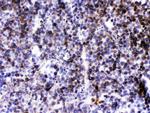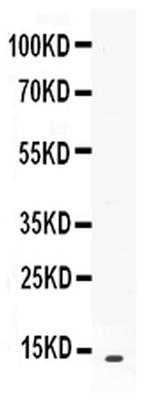Search Thermo Fisher Scientific
FIGURE: 1 / 2
CXCL13 Antibody (PA5-79106) in IHC (P)


Product Details
PA5-79106
Species Reactivity
Published species
Host/Isotype
Class
Type
Immunogen
Conjugate
Form
Concentration
Purification
Storage buffer
Contains
Storage conditions
Shipping conditions
RRID
Product Specific Information
Reconstitute with 0.2 mL of distilled water to yield a concentration of 500 µg/mL.
Target Information
CXCL13, also known as BCA-1 and Angie, is a small chemokine strongly expressed in the secondary lymphoid organs. It preferentially promotes the migration of B lymphocytes (both B-1 and B-2) to the follicles of the spleen, lymph nodes, and Peyer's patches. It is produced by macrophages, and in mouse the highest constitutive producers include large peritoneal macrophages, Kuppfer cells and lung macrophages (both CD11c+ and CD11c-). The cellular ligand for CXCL13 is CXCR5 also known as BLR-1 (Burkitt’s Lymphoma Receptor 1). CXCR5 is expressed on B cells, Tfh cells and, to a lower degree, some memory T cell populations. CXCL13 plays an important role in the development of chronic lymphocytic leukemia (CCL). CXCL13 is also a plasma biomarker for germinal center activity and generation of broadly neutralizing antibodies against HIV.
For Research Use Only. Not for use in diagnostic procedures. Not for resale without express authorization.
Bioinformatics
Protein Aliases: B lymphocyte chemoattractant; C Cmotif chemokine; C X C motif chemokine; C-X-C motif chemokine 13; CC motif chemokine; CCmotif chemokine; chem; CXC; CXC chemokine BLC; CXC motif chemokine; CXC motif chemokine 13; CXCL; small inducible cytokine subfamily B (Cys-X-Cys), member 13; Small-inducible cytokine B13
Gene Aliases: 4631412M08Rik; Angie; ANGIE2; BCA-1; BLC; BLR1L; Cxcl13; Scyb13
UniProt ID: (Mouse) O55038
Entrez Gene ID: (Mouse) 55985

Performance Guarantee
If an Invitrogen™ antibody doesn't perform as described on our website or datasheet,we'll replace the product at no cost to you, or provide you with a credit for a future purchase.*
Learn more
We're here to help
Get expert recommendations for common problems or connect directly with an on staff expert for technical assistance related to applications, equipment and general product use.
Contact tech support
